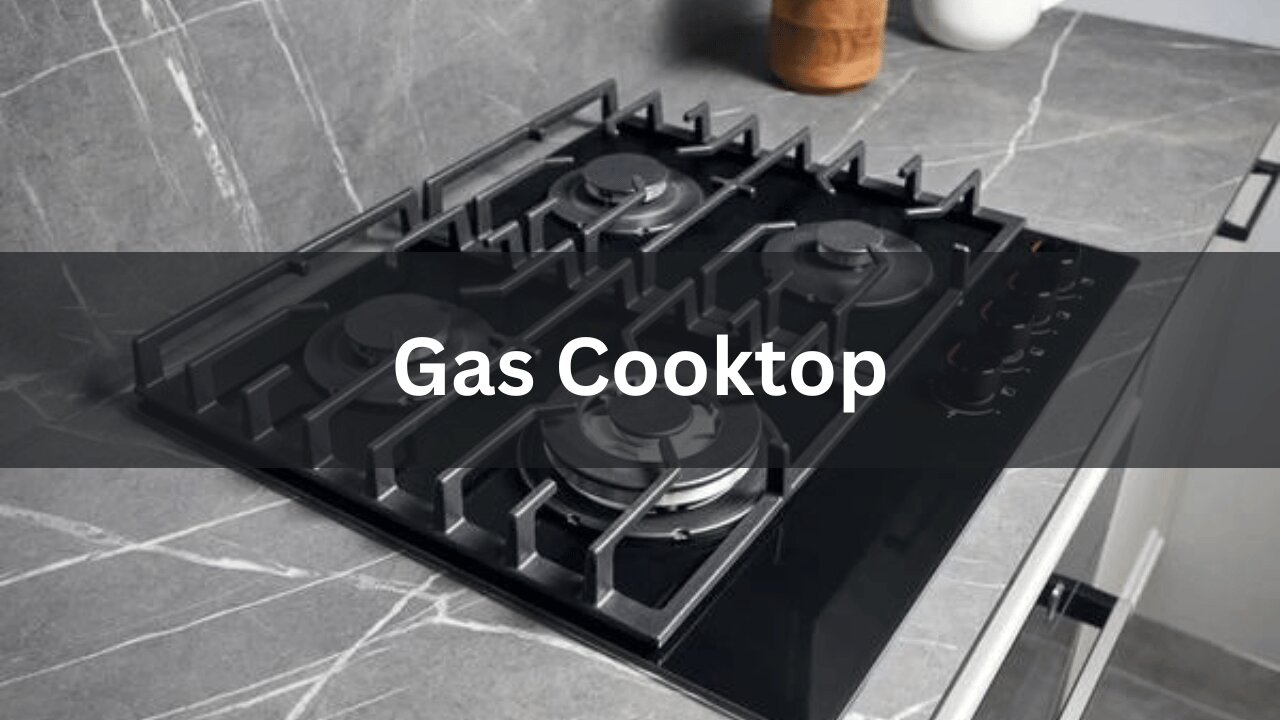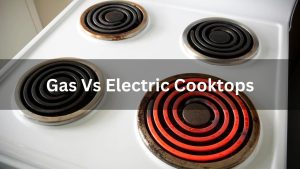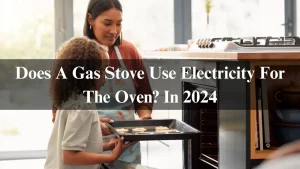Investing in a gas cooktop can significantly elevate your culinary experience, offering precise temperature control, rapid heat response, and versatile cooking capabilities. Whether you’re a seasoned chef or an enthusiastic home cook, the benefits of gas cooktops—such as even heat distribution and compatibility with various cookware—are undeniable.
Moreover, the modern advancements in design and safety features ensure you can enjoy both efficiency and peace of mind. By choosing a gas cooktop, you’re opting for a reliable, durable, and energy-efficient appliance that can transform your kitchen into a hub of creativity and gastronomic delight. So, if you’re considering an upgrade or a new addition to your kitchen, a gas cooktop is a choice that promises to ignite your passion for cooking
Table of Contents
What Is A Gas Cooktop?
A gas cooktop is a countertop appliance with burners fueled by natural gas or propane. It is known for its ability to heat instantly and control precise temperatures, making it ideal for various cooking techniques, from simmering delicate sauces to searing steaks.

Gas cooktops typically come in various sizes and configurations, ranging from simmer burners to high-powered BTU burners for intense heat. Many gas cooktops also feature grates made from cast iron or porcelain, which are durable and easy to clean.
History of Gas cooktop and whos invented it?
The credit for the gas cooktop goes to two inventors with interesting stories:
- Early Experiment (1802): A Moravian chemist named Zacchäus Winzler gets the nod for the earliest design around 1802. Unfortunately, his invention never got off the ground and wasn’t commercially produced.
- The Patented Success (1826): British inventor James Sharp takes the win for the first functioning gas stove patented in 1826. He even opened a factory in 1836 to produce them!
However, widespread adoption took some time. It wasn’t until the 1880s, when piped gas became available in cities, that gas cooktops truly became a success story in kitchens.
How Do Gas Cooktops Work?
A gas cooktop uses natural gas or propane to create a flame for cooking. Here’s a breakdown of how it works:
- Fuel Delivery: The cooktop is connected to a gas line that supplies fuel (natural gas or propane).
- Valve Control: Each burner on the cooktop has a control knob that connects to a valve. Turning the knob opens the valve, allowing gas to pass through.
- Air Mixing: As the gas flows through the valve, it travels through the burner tube and mixes with air, usually in the venturi section of the burner. This air-gas mixture is essential for efficient combustion.
- Ignition: A gas cooktop ignites a gas mixture using one of two methods:
- Electronic Ignition: Most modern gas cooktops use electronic ignition. When you turn the knob, a spark igniter creates a spark near the burner head, igniting the gas and air mixture.
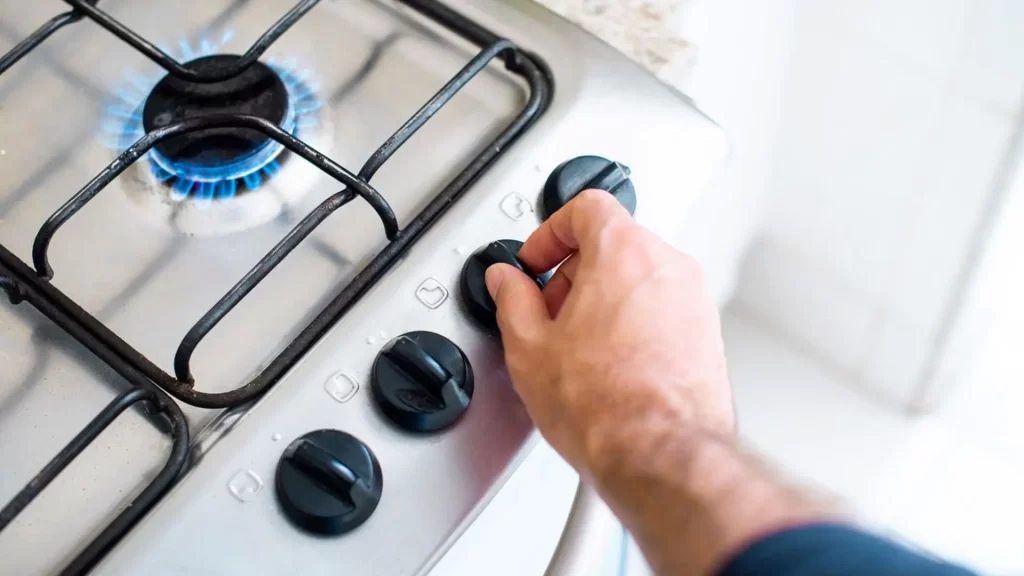
- Pilot Light: Some older gas cooktops have a pilot light, a small, constantly burning flame. As you turn the knob, the gas flow increases, and the large burner flame is ignited by the pilot light.
- Flame Control: The control knob allows you to control the amount of gas flowing through the burner, which controls the size of the flame and the intensity of the heat. A larger flame produces more heat for tasks like boiling or roasting, while a smaller flame is best for simmering or delicate cooking.
- Heat Transfer: The burner flame heats the bottom of your pots and pans, transferring heat to cook your food.
Additional Notes:
Gas cooktops are known for their responsiveness, allowing quick heat intensity adjustments.
Some gas cooktops, such as built-in grills or wok burners, may have additional features.
Gas cooktops offer an easy and efficient way to cook using a familiar flame-based heating method.
Top 5 Types of gas cooktop
Here’s a breakdown of the different types of gas cooktops:
- Freestanding Gas Cooktop: These cooktops are self-contained units with legs or a base that allows them to be placed on a countertop without any additional built-in features. They offer a classic look and are a good option for renters or those who don’t want to remodel their kitchen.
- Drop-In Gas Cooktop: These cooktops are designed to be installed directly into your countertop. They have unfinished edges that sit on top of the counter, and they are a good option for a more built-in look without permanent installation.
- Slide-In Gas Cooktop: Similar to drop-in cooktops, slide-in models also sit on the countertop but have a finished front that allows them to slide into a cutout. This creates a more seamless, built-in look.
- Sealed Burner Gas Cooktop: These cooktops have burners with a smooth, sealed surface around the flames. This makes them easier to clean than open burner cooktops, as spills are contained and less likely to drip down into the burner components.
- Open Burner Gas Cooktop: These cooktops have exposed burners with grates on top for holding your cookware. They offer a more traditional look and feel, and some chefs prefer them for the ability to visually control the flame. However, they can be more difficult to clean.
Pros Of Gas Cooktop
There are several pros to consider when choosing a gas cooktop for your kitchen:
- Precise Heat Control: One of the most significant advantages of a gas cooktop is its precise heat control. The flame responds immediately to adjustments made with the control knob, allowing you to increase or decrease heat as needed quickly. That’s essential for simmering delicate sauces, sauteing vegetables, or searing steaks.
- Instant On and Off: Gas cooktops deliver instant heat when you turn on the burner. You don’t have to wait for a heating element to get hot; you can start cooking immediately. Similarly, when you turn off the burner, the heat disappears immediately, reducing the risk of accidental scorching or overheating.
- Versatility for Cooking Techniques: Gas cooktops excel at various cooking techniques. The visible flame allows for even heat distribution, making them ideal for tasks like stir-frying or wok cooking. Additionally, the ability to control the flame size precisely makes them well-suited for low and slow simmering and high-heat searing.
- Works during power outages: Unlike electric cookyop, gas cooktops can work during power outages. If you have a gas supply, you can still cook your food, which can be a lifesaver in areas prone to power cuts.
- Pot and Pan Compatibility: Gas cooktops work with various cookware materials, including cast iron, stainless steel, aluminum, and copper, giving you more flexibility in your choice of cookware.
- Cost-Effective (in some areas): Depending on your location and utility rates, cooking with gas can be more cost-effective than using electricity. Natural gas prices tend to be more stable than electricity prices.
- Visual Feedback: The visible flame on a gas cooktop provides immediate feedback on the heat intensity. It can be helpful for new cooks who are still learning to judge heat levels.
Cons Of Gas Cooktop
Although gas cooktops offer many advantages, there are also some disadvantages to consider:
- Safety Concerns: Gas leaks and carbon monoxide poisoning are potential hazards associated with gas cooktops. Proper installation, ventilation, and maintenance are essential to reduce these risks. Make sure your home has working carbon monoxide detectors.
- Indoor Air Quality: Gas combustion can release pollutants like nitrogen dioxide and carbon monoxide into the air, potentially impacting indoor air quality, especially in homes with poor ventilation. It can be a concern for people with respiratory issues like asthma.
- Cleaning and maintenance: Gas cooktops can be more challenging than electric cooktops because of the grates and burner components. Food flakes and grease splatters can accumulate around the burners, requiring more effort to clean thoroughly.
- Uneven Heating: While generally good at heat distribution, gas cooktops can sometimes exhibit hot spots, particularly with older models or uneven burner designs. Adjusting pan placement is required for even cooking.
- Low energy efficiency: Gas cooktops are less energy efficient than electric cooktops, especially induction models. Some of the heat generated by the flame is dissipated into the surrounding air instead of going entirely toward heating your cookware.
- Limited counter space: Depending on your kitchen layout, a gas cooktop with multiple burners can take up a lot of counter space.
- Not environmentally friendly (depending on the source): Natural gas is a fossil fuel, and its combustion contributes to greenhouse gas emissions. However, this environmental impact is reduced if your gas supply comes from a renewable source such as biogas.
How To Use A Gas Cooktop?
Using a gas cooktop is relatively straightforward, but here’s a guide to ensure you get started safely and efficiently:
Before starting:
Consult your manual: It is always recommended to consult the user manual to familiarize yourself with your gas cooktop model’s specific instructions and features.
Lighting the Burner:
- Turn on the burner knob: Most modern gas cooktops have an electronic ignition. Simply push down and turn the knob clockwise for the desired burner. You should hear a click as the igniter sparks.
- Observe the flame: If the burner burns, you will see a flame. Adjust the knob further to control the flame size as needed.
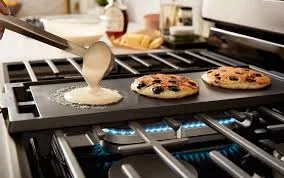
- Alternate lighting method (if applicable): Some older gas cooktops or models with faulty igniters may require manual lighting. In such cases, follow the manufacturer’s instructions for using a long-handled lighter to ignite the gas while the knob is turned to a low setting. Only attempt to light a gas cooktop with a match or any open flame source if your manual explicitly instructs you.
Cooking with Gas:
- Choose the right cookware: Gas cooktops work best with flat-bottomed, heavy-bottomed cookware made from materials like cast iron, stainless steel, or aluminum. Make sure your pot and pan make good contact with the burner grate.
- Heat Control: The control knob allows you to control the size of the flame and, thus, the intensity of the heat. A low flame setting is ideal for simmering or delicate tasks, while a high flame is suitable for steaming or sauteing.
- Safety during cooking: Keep flammable items such as pot holders or oven mitts away from open flames. Never leave a lit burner unattended.
Turn off the burner:
Simply turn the control knob clockwise until it clicks to a stop. The flame should be extinguished entirely.
Additional tips:
- Maintaining the cooktop: Regular cleaning is essential. Once the cooktop is cool, remove the spill and splatter. Consult your manual for proper cleaning instructions for grates and burner components.
- Ventilation: Use your kitchen vent or fan while cooking to help eliminate gas fumes or heat build-up.
- Safety First: Always put safety first when using your gas cooktop. Ensure proper gas line connections and working carbon monoxide detectors in your home. If you suspect a gas leak (a strong gas smell), immediately turn off the burner knobs, evacuate the area, and call your gas company or a qualified appliance technician.
Features of Gas cooktops
Gas cooktops are popular in many kitchens because of their precise heat control and versatility. Some of the key features of gas cooktops are:
1. Burner types and configurations
- Number of Burners: Usually from 2 to 6 to meet different cooking needs.
- Burner Sizes: Size and heat output vary, often including small, medium, and large burners.
- Special burners: Some models have special burners, such as a simmer burner for low-heat cooking or a high-output burner for rapid boiling.
BTU Rating
The BTU rating of a burner indicates how much heat it can produce. Higher BTUs are better for tasks like boiling water quickly or searing meat, while lower BTUs are ideal for simmering.
| Burner Size | Typical BTU Range | Best For |
| Small | 5,000 – 8,000 BTUs | Simmering, delicate tasks |
| Medium | 9,000 – 12,000 BTUs | General cooking |
| Large | 15,000 – 18,000+ BTUs | Boiling, searing |
2. Heat control
- Knobs and Dials: Most gas cooktops use knobs or dials to adjust the flame size and heat level.
- Electronic Ignition: Modern models use an electronic ignition system for safer and more efficient lighting of the burners.
- Continuous grates allow pots and pans to move quickly between burners without lifting them.
3. Materials and Finishes
- Stainless Steel: Durable and easy to clean, a common choice for gas cooktops.
Tempered glass offers a sleek look and is easy to clean, although it can be less durable than stainless steel.
- Cast iron grates are usually coated with porcelain, making them easier to clean and more durable.
4. Safety features
- Flame Failure Device: Automatically shuts off the gas supply if the flame goes out.
- Child Lock: Prevents accidental ignition by locking the controls.
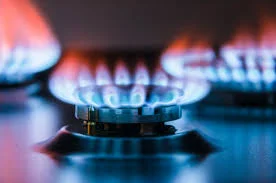
5. Additional features
- Sealed Burners: Prevent food and debris from entering the burner area, making cleaning easier.
- Convertible Kits: Allow conversion between natural gas and liquid propane.
- LED indicator: Some models have lights indicating that the burner is on or the surface is hot.
- Integrated griddle: Some cooktops come with a removable grill for added versatility.
6. Ease of cleaning
- Removable Grates and Burner Caps: Simplify cleaning by allowing these parts to be removed and washed separately.
- Smooth Surface Design: Minimizes crevices where food can get stuck.
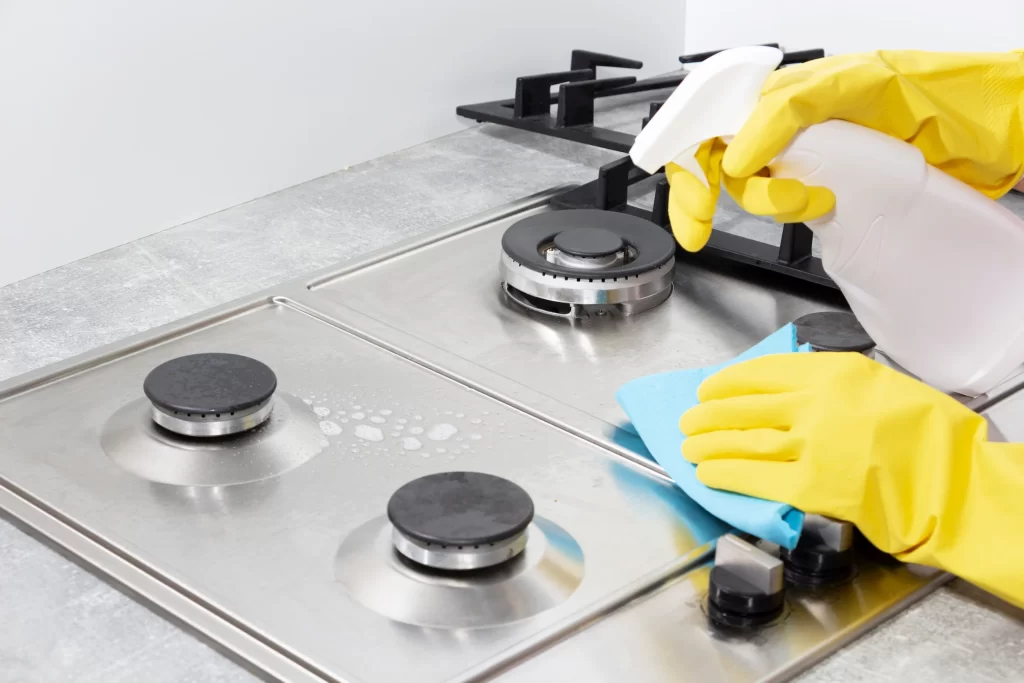
7. Dimensions and Installation
- Standard Sizes: The most common sizes are 30-inch and 36-inch, but other sizes are available for different kitchen configurations.
- Built-in or standalone: Gas cooktops can be installed into countertops or come as standalone units.
8. Energy efficiency
- Energy Star Ratings: Some models are designed to be more energy efficient, reducing overall gas consumption.
9. Brand and Warranty
- Reputable brands: Quality and features can vary significantly, with some offering more advanced features or better customer support.
- Warranty: Most gas cooktops come with a manufacturer’s warranty that covers parts and labor for a specified period.
How We Selected the Best Gas Cooktops
Choosing the best gas cooktops involves comprehensively evaluating various models based on several criteria. Here is a detailed breakdown of the selection process:
1. Efficiency and effectiveness
- Heat Output: The burners’ BTU (British Thermal Unit) rating is evaluated to ensure the appropriate heat output range for different cooking needs, from high to low heat. Take a boil.
- Ignition System: Reviewed the reliability of the ignition system, preferring models with electronic ignition for consistent and safe operation.
2. Design and build quality
- Materials: The durability and aesthetics of the materials used, such as stainless steel, tempered glass, and cast iron grates, were evaluated.
- Construction: Look for solid construction and sturdy grates that support heavy cookware without swaying.
3. Ease of use and maintenance
- Control Layout: Checked the ergonomics and accessibility of the control knobs and dials, ensuring they are intuitive and easy to use.
- Cleaning: Features that make cleaning easy are considered, such as sealed burners, removable grates, and smooth surfaces.
4. Safety features
- Flame failure devices: Preferred models with flame failure safety devices that automatically cut off the gas supply in case of flame failure.
- Child Lock and Heat Indicators: Additional safety features like lock and heat indicators have been reviewed.
5. Versatility and additional features
- Burner Variety: For versatility in cooking, I prefer cooktops with various burner sizes and types (e.g., simmer burners and high-output burners).
- Integrated accessories include accessories like grills or wok rings that enhance functionality.
6. Brand reputation and customer reviews
- Brand Reliability: Models chosen by brands known for their quality and customer service.
- Customer Feedback: Analyzed customer reviews and ratings to understand real-world performance and customer satisfaction.
7. Energy efficiency
- Efficiency ratings: Energy efficiency ratings and features contributing to low gas consumption are tested.
8. Size and Compatibility
- Standard sizes: Ensure availability in standard sizes (e.g., 30-inch and 36-inch) to fit different kitchen layouts.
- Installation Flexibility: Remarkable models that offer easy installation and compatibility with both natural gas and liquid propane.
9. WARRANTY AND SUPPORT
- Warranty coverage: Check the length and terms of the manufacturer’s warranty, covering parts and labor.
- Customer Support: Reviewed the availability and quality of customer support services.
10. Value for money
- Price vs. Features: The cooktop’s price should be balanced against its features and performance, ensuring good value for money.
- Hands-on Testing: Whenever possible, conducted hands-on testing of models to evaluate performance, usability, and build quality.
- Expert Reviews: Expert reviews and ratings from trusted sources in the home appliance industry were consulted.
By carefully evaluating these factors, we aim to select gas cooktops that offer the best performance, safety, ease of use, and price for various cooking needs and kitchen setups.
Tips For Taking Care Of Your Gas Cooktops
Here are some tips to keep your gas cooktop functioning efficiently and looking its best:
- Clean up spills as soon as they happen: Don’t let spills and food debris build up on cooktop surfaces or grates. Remove them immediately after cooking while the cooktop is hot for easy cleaning. A cloth dampened with warm, soapy water is usually sufficient for everyday cleaning.
- Regularly deep clean: For more thorough cleaning, periodically dispose of the grates and burner components, depending on the frequency of your use. Monthly cleanings are a good rule of thumb. Soak the grates in warm, soapy water or a baking soda to loosen stuck-on dirt. Use a soft-bristled brush or a dedicated cooktop cleaning tool for more challenging spots. Refer to your manual for specific cleaning instructions for your cooktop model.
- Avoid harsh cleaners: Use mild cleaning solutions like dish soap, baking soda, or white vinegar. Harsh chemicals or abrasive scrub pads can damage the cooktop’s surface and finish.
- Clean Burner Heads: Clogged holes can affect flame ignition and heat distribution. Use a fine wire or pipe cleaner to remove debris or food particles from the burner head holes. Never use a toothpick or anything sharp that could damage the delicate pores.
- Periodically inspect and tighten burner components: Grates and caps can become slightly loose over time. Make sure they are correctly seated, and hand-tighten any loose components. Consult your manual for any specific recommendations from the manufacturer.
- Do not place heavy objects on the grates: While sturdy, avoid placing hefty dishes or a Dutch oven on them, as this can stress the cooktop support and potentially damage the grate enamel.
- Keep the area ventilated: Turn on your vent hood or open a nearby cooking window to remove smoke, heat, and moisture. That will help prevent grease build-up and make cleaning easier.
- Professional Maintenance Schedule (Optional): For optimal performance and safety, consider having your gas cooktop professionally serviced periodically by a qualified appliance technician. They can check for gas leaks, ensure proper burner operation, and fix any potential problems before they become significant problems.
Following these tips ensures that your gas cooktop gives you years of reliable and safe cooking enjoyment.
People Also Read: How to Clean a Gas Stovetop
Gas Cooktop vs. Gas Range: Key Differences
| Feature | Gas Cooktop | Gas Range |
| Design | Installed in countertop | Includes oven and stovetop |
| Flexibility | Can be paired with wall oven | Less flexible placement |
| Installation | Requires countertop cutout | Needs more space |
| Cost | Typically lower | Higher, due to dual functions |
What is a Gas Stove?
A gas stove is a workhorse in the kitchen, using natural gas, propane, or butane to fuel burners that directly heat your cookware with open flames. This allows for responsive control over temperature, perfect for tasks like simmering or boiling. The classic gas stove features a cooktop with burner grates and knobs for gas flow control. Many gas stoves also come with a built-in oven for baking and roasting. Compared to electric or induction cooktops, gas stoves offer a familiar and traditional cooking experience.
Smart and High-End Gas Cooktops in 2024
Many 2024 gas cooktops come with smart features like Wi-Fi connectivity, allowing users to monitor burners remotely through smartphone apps. High-end models also include dual-fuel options, combining gas burners with electric heating elements for more cooking flexibility.
Common Problems and Troubleshooting Tips
1. Burner Won’t Ignite
- Check if the burner cap is aligned correctly.
- Ensure there is no food debris blocking the ignition ports.
2. Weak Flame or Uneven Heating
- Adjust the gas regulator to increase pressure.
- Inspect the gas line for potential blockages.
3. Gas Smell
- Turn off the gas supply immediately and call a technician to inspect for leaks.
Related Articles:
What Is The Best Material For A Gas Cooktop? Info 2024
How To Choose The Right Gas Cooktop For Your Kitchen? 2024
Gas Stoves that You Need To Know About It Latest Info 2024
Installation Of Gas Cooktop Latest Method 2024
Conclusion
Finally, gas cooktops offer a unique cooking experience valued by many chefs and home cooks. Their responsiveness, precise heat control, and versatility make them ideal for various cooking techniques. However, they also have drawbacks, such as safety concerns, potential impacts on indoor air quality, and more complex cleaning than electric cooktops.
Ultimately, deciding between gas and electric cooktops depends on your preferences, cooking style, and kitchen setup. A gas cooktop may be your best choice if you value flame response and control and prefer economy in certain areas. Just remember to prioritize safety with proper installation, ventilation, and maintenance, and enjoy the culinary adventures your gas cooktop can bring!
FAQS
FAQs
Can I install a gas cooktop myself?
It is recommended to hire a licensed professional to ensure proper installation and safety.
How much does a gas cooktop cost in 2024?
Prices range from $500 to $3,000, depending on size, brand, and features.
Are gas cooktops being banned?
Some cities are limiting gas installations in new buildings, but existing homes can still use gas appliances.
What type of gas is used for gas cooktops?
Most gas cooktops use natural gas, but they can also run on propane with a conversion kit.
How often should I clean my gas cooktop?
Clean the burners, grates, and surface weekly to prevent clogs and maintain performance.

